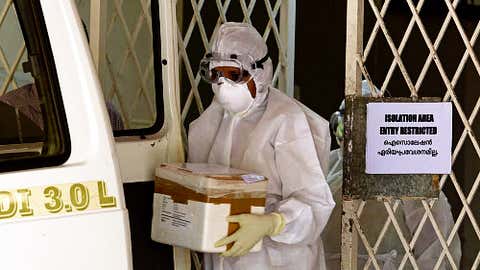Infection
Nipah Virus FAQs: All About the Infection That Claimed 2 Lives in Kerala

Health official with samples collected from an isolation ward set up for Nipah cases to be sent to Virology Institutes in Pune and Alappuzha.
(Jipson Sikhera)
Nipah virus infection has resurfaced in Kozhikode district for the third time in the past five years, with tests conducted at the National Institute of Virology, Pune confirming it in the death of a 40-year-old man, Mangalatt Haris of Ayanchery, on Monday as well as two relatives of a 49-year-old man, Kallat Mohammedali of Maruthonkara, who died on August 30.
As the Kerala government gears up to fight the virus and prevent it from spreading, let’s take a closer look and understand what the Nipah virus is, what causes it, how it can be treated and more.
What is the Nipah virus?
The Nipah virus, or NiV, is a zoonotic virus, which means that it can traverse the interspecific barrier and spread from animals to humans. While fruit bats (Pteropodidae family) are the natural animal reservoirs for NiV, pigs and humans have also been infected with the virus.
NiV was first discovered after an outbreak in pigs and humans in Malaysia and Singapore in 1999. It resulted in nearly 300 humans getting infected, of which 100 died. It also had a significant economic impact, as over 1 million pigs were slaughtered to help staunch the outbreak. Annual outbreaks of this virus are common in Asian countries such as Bangladesh and India.
How can one get infected by the Nipah virus?
The underlying cause of outbreaks has been cited as direct contact with infected pigs, other infected animals, contaminated fruits (half-eaten fruits left by fruit bats), and even direct contact with sick people.
To keep yourself from getting infection, make sure you avoid: contact with sick bats or pigs, areas where bats are known to roost, consumption of raw date palm sap, consumption of fruits that bats may contaminate, and contact with the blood or body fluids of any person known to be infected with the virus.
What are the symptoms of Nipah virus infection?
Some symptoms of NiV to look out for are fever, headache, fainting, nausea, choking, stomach pain, vomiting, fatigue, and blurred vision. Encephalitis and seizures could also occur in severe cases and progress to coma within 24 to 48 hours.
Based on the documentation, the symptoms may range from mild to severe.
How fast does the Nipah virus spread? Is there any reason to worry?
While the NiV has a higher death rate as compared to COVID-19, it does not spread as fast as the SARS-CoV-2. Most NiV outbreaks have been contained relatively quickly and have only been detected in sparsely populated regions where the chances for widespread transmission are eliminated. The probability of transmission from one human to another is also pretty low.
According to a study published by Bangladeshi researchers, the reproductive number (R0) in previous Nipah virus outbreaks was around 0.48. The R-value quantifies how quickly the virus can spread in a population. A value less than one is indicative of the fact that less than one person will get infected by a previously infected person. In such circumstances, the risk for an extensive outbreak gets mitigated quickly.
How can the Nipah virus infection be treated?
Due to limited outbreaks, we do not have any vaccine that could immunise us against this virus, nor are there viable treatment options. Most treatment measures focus on supportive care.
What is the death rate for Nipah virus?
NiV has a mortality rate between 40% and 75%, according to the Centres for Disease Control and Prevention (CDC). In comparison, COVID-19 has a death rate of around 1% in India.
What measures has the Kerala government taken against the Nipah virus so far?
The Kerala government has taken several steps in response to the Nipah virus outbreak, including isolating high-risk contacts, using monoclonal antibody treatment, deploying central teams, conducting a bat survey, and implementing surveillance and contact tracing with the help of CCTV footage and police. Route maps of infected individuals’ movements will also be made public, and multiple core teams have been formed for various tasks, with a control room set up at the Kozhikode guest house.
**
For weather, science, and COVID-19 updates on the go, download The Weather Channel App (on Android and iOS store). It’s free!

